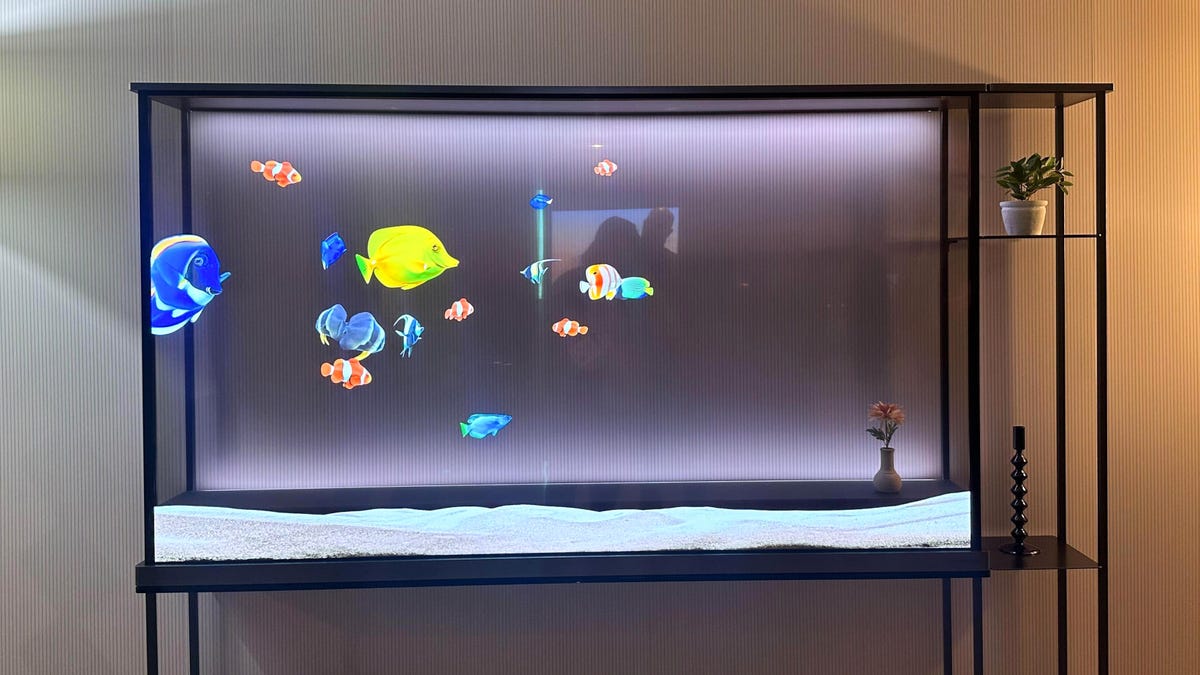 Why You Can Trust CNET
Why You Can Trust CNET Are Transparent TVs the Next Big Thing?
Sci-fi looks and tons of hype. Your next TV may be see-through.

LG's transparent OLED
At CES 2024, both LG and Samsung debuted big screen transparent TVs. Like something out of science fiction, these are absolutely as crazy as they sound. When the TVs is off, it's like it's no longer there. Not invisible exactly, but if you didn't know what it was, you'd never guess that in a fraction of a section it could be showing episodes of Star Trek or The Expanse. While in development for many years, and available in some sizes commercially, transparent screens saw a big push towards the mainstream this year as actual televisions.
With the biggest TV manufacturers hyping this new technology, could a transparent TV be in your life soon? After all, it was only a few years ago these same companies showed off future tech like micro-LED and OLED, and they're available everywhere now.
The answer is yes -- but perhaps not in the way you think.
Transparently magic
A transparent micro-LED screen. Note the microscope on the right supplying a closeup of the panel shown on tablet at the bottom.
Before we peek into the future, let's look at the present. While transparent TVs look like something dreamed up by Hollywood special effects artists, they're surprisingly more of an evolution in TV tech, not something entirely revolutionary. The core technologies of all the transparent TVs shown at CES are versions of that company's TV tech. For example, LG's transparent TV is OLED, and Samsung's is micro-LED.
As far as the future of this tech is concerned, that's a good thing. While making a transparent version of a TV is by no means trivial, it's more like making clear door panels for a car that's already being built, not reinventing the car. Using as much existing manufacturing and design knowhow as possible means these screens could be affordable to us mere mortals within a few years. LG says it plans to sell its version later this year, but you should have no doubt it will be exceptionally expensive. At least, for a while.
Transparent future
Three potential sizes and resolutions for LG's transparent OLED televisions.
So will your next TV be transparent? Almost certainly not. While neither company is talking about prices, these will be costly. No surprises there, since these are first generation technologies. We can look to Xiaomi's $7,200 55-inch transparent TV for some hints. Is $10,000 for LG's 77-inch possible? For sure, but probably even more.
Eventually the prices will fall, but even then it's likely you won't want one. At least, you won't want one for your main TV. This is because transparent TVs can't "create" black. To get a watchable image of your favorite TV show or movie, something has to supply the black, otherwise the image is going to look very weird. The LG, for example, has a roll-up back panel to aid in creating the contrast needed for real video. This is why these companies are demoing the TVs with fish, numbers and data, and other content that doesn't require black portions of the image.
It's unlikely transparent TVs will ever look as good as a non-transparent TV. Maybe that's fine if that's what you want in a TV, but given the assumed price premium, most people will probably feel it's not worth it. For most situations, the transparent aspect will be a neat trick for the occasional party, but it will stay in nontransparent mode most of the time. If that's the case, is the extra cost worth it? New OLEDs like the LG G4 and C4 will likely look a whole lot better and for a whole lot less.
While undeniably cool as a futuristic statement piece in your house, transparent TVs are likely to find more practical uses elsewhere. For example, store windows that let you see inside and show you prices and ads. Windows that can let you see outside while showing a stock ticker, weather highlights, emails and ads, or the glass in a stadium's box seats where you can see the action on the field, but also see scores and highlights on a transparent screen. On the consumer side, LG even has a prototype tube/speaker combo mounted inside a transparent TV.
What transparent TVs actually do is expand the number of places you can display information, and yes that includes more places to display ads. So it goes. That ability to make money is what's going to accelerate their acceptance, which will drive down the cost of the technology. That will make them even more accessible, and potentially end up in your home... just perhaps not as your main TV.
As well as covering TV and other display tech, Geoff does photo tours of cool museums and locations around the world, including nuclear submarines, massive aircraft carriers, medieval castles, epic 10,000-mile road trips, and more.
He wrote a bestselling sci-fi novel about city-size submarines, and also Budget Travel for Dummies. You can follow him on Instagram and YouTube.

